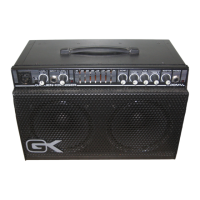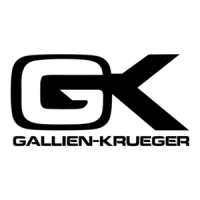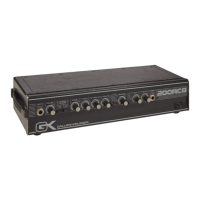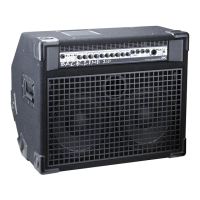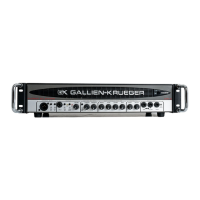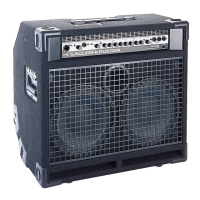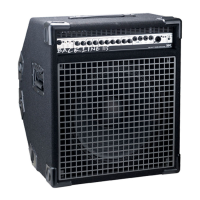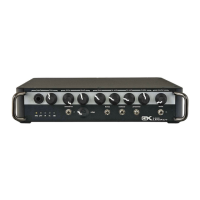Do you have a question about the Gallien-Krueger 2001RB and is the answer not in the manual?
Ensuring correct power source compatibility for safe operation and amplifier protection.
Confirming adequate power circuit amperage to prevent tripping and ensure performance.
Procedures for safely isolating the amplifier from the AC power source.
Guidelines and warnings against using extension cords for safety and reliability.
Warning against opening the enclosure due to shock hazard and warranty voidance.
Advice on saving packing materials for future transport or repair needs.
Step-by-step instructions for connecting the amplifier to a power outlet.
Guidance on connecting speaker cabinets to the amplifier's outputs.
Recommended initial settings for front panel controls for basic operation.
Instructions for plugging in the bass and setting initial volumes.
How to set master volume and level for optimal sound output.
Suggested amplifier settings for achieving a 'Tube Style Grunge' tone.
Recommended settings for a high-gain, distorted sound profile.
Suggested amplifier settings for a deep, resonant bass tone.
Recommended settings for a bright, articulate 'slap' bass sound.
Tips on using the EQ for fine-tuning tone with small, impactful changes.
How the Contour control scoops mids and boosts highs/lows for unique GK sound.
Using the String Bass button to adapt the amp's response for 4 or 5-string basses.
Optimizing tone and growl by adjusting Boost and Master volume levels.
Using the balanced direct out for PA/recording, including Pre/Post EQ options.
Crucial warning against using incorrect Speakon cables in bridged mode.
Connecting RBH cabinets for Bi-Amp mode using 4-conductor Speakon cables.
Connecting standard cabinets using 2-conductor Speakon or 1/4" cables.
Proper placement, rack mounting, and ventilation for safe installation.
Steps to safely disconnect and move the amplifier unit.
Recommended methods for cleaning the amplifier unit without damage.
Basic maintenance advice, emphasizing cleaning and protection.
Description of Input, -10dB PAD, Clip LED, and Tuning Mute controls.
How to switch between Clean (A) and Overdrive (B) channels.
Details on Gain, Edge, Bottom, and Level-B for the overdrive channel.
Explanation of Level-A, Voicing Filters (4/5 String Bass, Contour, Presence).
Description of Treble, High Mid, Low Mid, and Bass EQ controls.
Explanation of Boost, Tweeter, and Woofer controls for Bi-Amp mode.
Understanding the Power/Protect LED and Power Switch functions.
Power input and remote trigger functionality for master/slave setups.
Description of Right Speakon outputs for Bi-Amp and Full-Range operation.
Controls for Right channel level and switching to Bridge mode.
Details on Left/Bridged Speakon outputs for Bi-Amp and Bridged modes.
Connecting footswitch and using the Direct Out for PA/recording.
Ground Lift switch and Pre/Post EQ selection for Direct Out.
Direct Level Out, Send, Return, and Tuner output descriptions.
Using Chain In/Out for connecting multiple master/slave units.
Critical warning about connecting 540W and 50W amps to speakers.
Overview of key features like high current output and Bi-Amp sound.
Explanation of the amp's ability to handle transients and maintain cone control.
Benefits of Bi-Amp for separate woofer/horn amplification and tone control.
How the electronic crossover provides seamless sound and reduces signal corruption.
GK's approach to EQ as specialized circuits for bass frequencies.
Detailed explanation of Contour and String Bass voicing filter effects.
Explanation of Gate Induced Valve Effect for harmonic content emphasis.
How dual rail power supply and fan cooling ensure reliability.
Description of safety circuits that monitor for unsafe operating conditions.
Benefits of the high gain, low noise input stage for reduced hiss.
Table detailing pin connections for 4-conductor Speakon cables.
Information on how to acquire extra Speakon cables.
Final thoughts and contact information for feedback.
Schematic representation of the amplifier's internal signal flow.
Detailed technical specifications for the 2001RB amplifier.
Detailed technical specifications for the 2001RBP preamplifier.
Voltage and power consumption details for different regions.
| woofer amplifier power | 2 x 540W @ 2 Ohms, 2 x 360W @ 4 Ohms, 2 x 240W @ 8 Ohms |
|---|---|
| woofer amplifier power (bridged) | 1080W @ 4 Ohms, 650W @ 8 Ohms |
| horn amplifier power | 50W @ 4 Ohms |
| power requirements (U.S.A./Canada) | 120V/60Hz |
| full power consumption (U.S.A./Canada) | 2250W |
| average power consumption (U.S.A./Canada) | 595W |
| power requirements (Europe) | 230V/50Hz |
| full power consumption (Europe) | 2250W |
| average power consumption (Europe) | 595W |
| power requirements (Japan) | 100V/50Hz |
| full power consumption (Japan) | 2250W |
| average power consumption (Japan) | 595W |
| maximum input level | 0.6V Rms |
|---|---|
| maximum input level with -10dB pad | 1.6V Rms |
| input impedance | 1M Ohm |
| send output impedance | 220 Ohms |
| return input impedance | 50k Ohms |
| tuner output impedance | 10k Ohm |
| direct output impedance | 500 Ohms |
| cooling | Continuously Variable-Speed Fan |
|---|---|
| amplifier protection | Full short circuit, thermal & RF protection |
| warm up time | Five second muted warm up |
| dimensions (HxWxD) | 5.25” x 19” x 12” |
|---|---|
| weight | 40 lbs |
